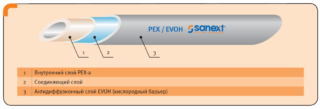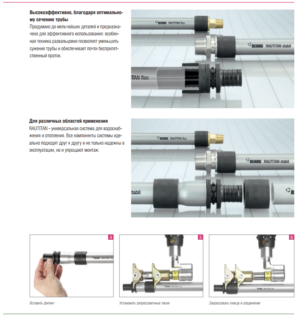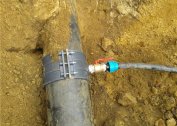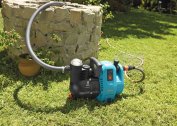Modern technologies make it possible to obtain qualitatively new materials for laying engineering networks. One of these is cross-linked polyethylene pipes. The low-temperature highway allows you to transport water or a coolant with a temperature of up to +80 degrees through it. According to reviews, the system is easy to install and shows its best side during operation.
Technical characteristics of cross-linked polyethylene water pipes
Material that has become so popular is classified depending on how it is crosslinked. From here, its technical characteristics also change. There are such types of tubes:
- PE-Xc (PEX-C). Chemical polyethylene is crosslinked. Possible diameters of such pipes are up to 32 mm. The level of crosslinking of the material is 60%.
- Pex-b. Tubes are stitched physically. The material is quite rigid, so the range of sections varies from 40 to 63 mm. This polyethylene is crosslinked by 65%.
- PEX-A. The most popular type of tube. Crosslinked by the peroxide method. Diameter range - from 12 mm and more. Such tubes are plastic, bend well. The level of crosslinking of the material reaches 70%.
All types of pipes are produced in accordance with GOST 25134-2003.
Main technical characteristics of polyethylene material for water supply:
- Optimum operating temperature - up to +80. They withstand water and coolant up to +120 degrees for a short time.
- With a constant temperature load, the pipes serve up to 50 years. With critical fluctuations (heat / cold) - up to 15-25 years.
- The mass of a running meter of a product - from 88 to 250 gr. depending on the diameter of the tube.
- The specific gravity is 0.932 g / cm3
- The coefficient of thermal conductivity is 0.405 watts.
- The volume of water in a cross-linked polyethylene water pipe with a cross section of 16 mm is 0.113 l; with a diameter of 20 mm - 0.210 l.
- Bending radius - from 80 mm and above depending on the section. The elastic modulus of such tubes is in the range 605-909 N / mm2.
- Elongation at break - 349%.
When exposed to high temperatures on polyethylene, the material does not emit toxic substances into the atmosphere. It is lightweight in operation and does not require the use of sophisticated equipment.
Criterias of choice
 When choosing a material for laying a water supply system, it is advisable to pay attention to such points:
When choosing a material for laying a water supply system, it is advisable to pay attention to such points:
- Crosslinking method of polyethylene. Responsible for the degree of crosslinking of the material. The most resistant is considered polyethylene marked PEX – A. It is most often used for heating systems, although other types of cross-links are suitable for water supply.
- UV protection marking. It is needed if the water supply is laid externally and openly. In this case, UV-1 or UV-2 marking is required. The first suggests that polyethylene is protected from exposure to sunlight. The second indicates stabilizers added to the material.
- Diameter. For the inner part of the water supply, products with a cross section of 16-25 mm are taken. For the outside (when supplying water from a well or well), large sections can be used.
When buying, you also need to pay attention to the brand of the manufacturer. It’s better to overpay a little and buy high-quality material than to use artificially manufactured pipes later on. The most popular are the products of the German brand Rechau. The seller needs to ask for quality certificates and a receipt for the goods.
Mounting Features
 When installing plumbing communication, it is important to pay attention to such points:
When installing plumbing communication, it is important to pay attention to such points:
- Work is performed at a temperature of +10 degrees. In this case, normal ductility of the pipeline is ensured.
- Communication installation, joining of individual elements is carried out only with the help of special fittings and tools suitable for cross-linked polyethylene. Amateur performance in this situation will not lead to good.
- If the tubes were transported or stored at a temperature regime of up to +10 degrees, it is necessary to warm them up during the day at room temperature.
- Tube bending to a limit value must be carried out with preliminary heating of the material using a building hair dryer. Polyethylene is heated at a temperature of +130 degrees using a spring conductor.
- If at the time of bending the pipe burst, it is better to replace this segment of the water supply. Professionals assure that the integrity of polyethylene can be restored, but you should not jeopardize the entire system. In the future, even a carefully patched defect may manifest itself.
- It is forbidden to use pipes made of cross-linked polyethylene at a working pressure of more than 10 bar.
If the material is used for laying a warm floor, first all hydraulic tests of the system are carried out and only then the screed is poured. At the time of pouring the solution, it is important to keep the tubes under a working pressure of 0.3 MPa.
Advantages and disadvantages
 New and popular material has several advantages and disadvantages. Positive points:
New and popular material has several advantages and disadvantages. Positive points:
- High ductility of pipes and their good "memory". The water supply retains its predetermined shape without the use of special fittings.
- Good material strength even at constant temperature fluctuations.
- Resistance of cross-linked polyethylene to mechanical stress, shock, friction.
- Preservation of strength in places of bending.
- Inertness of the material to aggressive environments and microorganisms.
- The absence of corrosion, even with long periods of operation of the water supply.
- Eco-friendly polyethylene. It does not contain heavy metals or halogens.
The disadvantages include:
- Exposure of pipes to ultraviolet (if there is no special labeling). Under the influence of the sun, polyethylene begins to break down, so it is not used for outdoor communications.
- The cost of tubes of cross-linked polyethylene is several times higher than the price of products PPR or PVC.
A high price tag is both a disadvantage and a virtue at the same time, since good pipes cannot be cheap.
Reviews of cross-linked polyethylene water supply
Michael, 35 years old: Recently, a new water supply system was being pulled from the father-in-law's house. We decided to take Rehau pipes from cross-linked polyethylene. Father-in-law has been engaged in plumbing for about 15 years. I liked working with the material. The pipes are lightweight, mounted using a special tool and sleeve. As a result, we get a system with a connection error probability of 0. Ideal, beautiful, reliable and in German.
Anton, 28 years old: I ran into pipes of cross-linked polyethylene about a year ago. Kum made a warm floor in the country. In work, everything turned out quickly due to the fact that nothing needs to be soldered. The only nuance, it is better not to put brass fittings in the screed. To date, the warm floor is working properly. Of course, only a year has passed, but I think no matter how much time has passed, German quality will not let you down.
Yuri, 41 years old: In his parents' house, he used pipes made of cross-linked polyethylene Rehau for water and heating. I liked that the material is flexible and easy to use. To connect the system, he took a special tool for rent. Recently there was a small accident - the boiler of the parents turned off and the system froze. After defrosting, the pipes remained intact and did not burst anywhere. What quality means!



